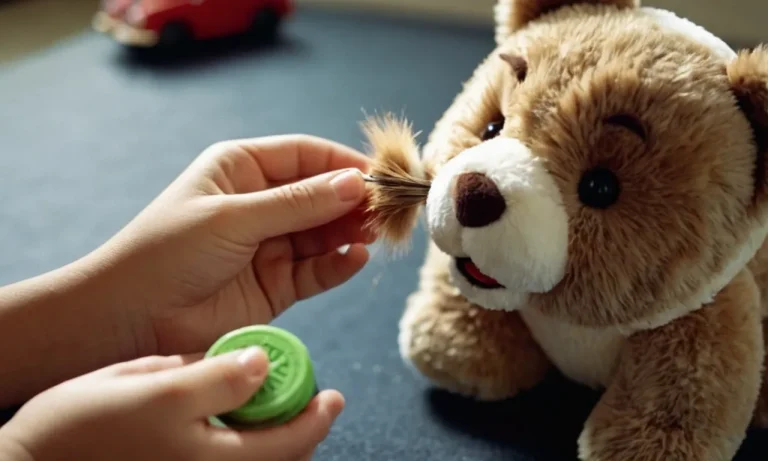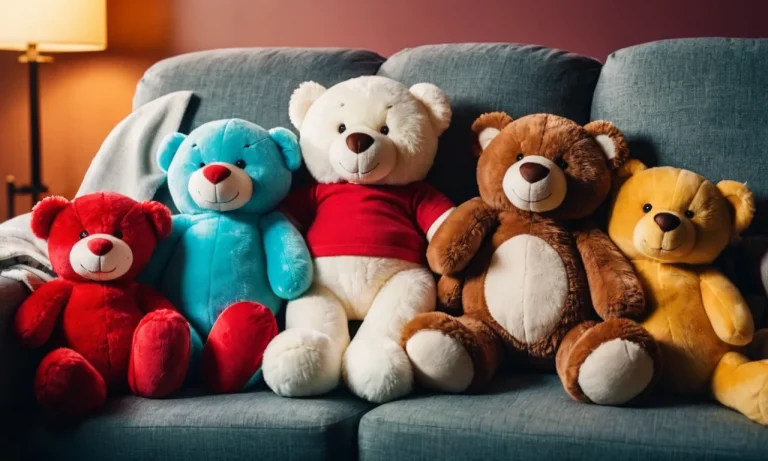Stuffed animals have been a beloved part of childhood for generations. Their soft, cuddly nature provides comfort and joy to children across the world. But have you ever wondered how the first stuffed animal came to be?
What inspired someone to take fabric and stuffing and shape it into a plush companion?
If you’re short on time, here’s the quick answer: Stuffed animals were first invented in the late 1800s as more realistic toy animals for children. Taxidermists experimented with using wood wool and other soft stuffing materials to create 3D animal toys that were soft to the touch versus rigid taxidermy mounts.
In this article, we’ll explore the full history behind the invention of stuffed animals – from early toy animal manufacturing to the first teddy bears made in honor of Theodore Roosevelt up through the stuffed animal boom we see today.
The Earliest Stuffed Animal Prototypes
Traditional Toy Animal Manufacturing
Stuffed animals trace their origins back thousands of years to traditional toy making. Ancient civilizations around the world crafted rudimentary toy animals out of materials at hand like straw, rags, or wood for children to play with.
More refined stuffed animal manufacturing emerged in the 1800s. This coincided with the Industrial Revolution which enabled mass production of goods. Toy makers started experimenting with early plush fabrics and stuffing materials to create soft, huggable toy animals.
These first true “stuffed animals” were made from fabrics like felt, velvet, or mohair and stuffed with natural fillers like straw, sawdust, cotton, or wool. They were entirely hand-stitched and produced in small quantities as precious playthings for only the most affluent Victorian households.
Taxidermy Innovations Lead to 3D Stuffed Animals
The 1880s brought major innovations that shaped modern stuffed animals thanks to the rising popularity of taxidermy. Taxidermists developed new techniques for mounting animal hides over 3D forms made of wood, wire, and excelsior – a fine wood wool stuffing.
These methods were soon adapted by toy makers, who used soft fabrics in place of animal hides to cover body forms that better replicated an animal’s natural shape. This allowed much more lifelike stuffed animals compared to flat fabric cutouts.
The iconic modern teddy bear emerged in 1902 inspired by a political cartoon of President Theodore “Teddy” Roosevelt. The cartoon spurred demand for toy “Teddy bears” made using cutting-edge 3D stuffed animal methods. Their success fueled massive popularity of plush toys through the 20th century.
Today, stuffed animals are a $13.6 billion dollar global industry. Modern materials like synthetic fur and stuffing enable mass production of these beloved plush companions now central to so many childhood memories.
The Origin Story of the Teddy Bear
The Inspiring Tale of Theodore Roosevelt and the Bear Cub
The origin story of the teddy bear is an endearing tale intertwined with 26th U.S. President Theodore “Teddy” Roosevelt. In November 1902, Roosevelt embarked on a 4-day bear hunting trip near Onward, Mississippi.
After several days with no luck, Roosevelt’s assistants found an injured bear cub and tied it to a tree for the President to shoot. Roosevelt viewed this as unsportsmanlike and refused to kill the helpless cub.
News of Roosevelt’s compassion spread quickly and was featured in a Washington Post editorial cartoon showing the moment of mercy (1).
The story captured the hearts of the American public. Around the same time, the Steiff Company in Germany produced stuffed toy bears with jointed limbs (2). After seeing the growing popularity of “Teddy’s bears” in the U.S., Steiff began selling their stuffed bears in America and officially named them after Roosevelt in 1903, kickstarting the teddy bear phenomenon (3).
The First Teddy Bears Created in Honor of Roosevelt’s Adventures
In 1902, Russian Jewish immigrant Morris Michtom was inspired to create the first teddy bear after seeing the cartoon of Roosevelt and the bear cub. Michtom’s wife sewed a stuffed bear prototype out of velvet scraps, which they displayed in their Brooklyn candy shop window with a sign “Teddy’s bear,” sparking interest from customers.
They went on to found the Ideal Novelty and Toy Company in 1903 to produce stuffed bears based on Michtom’s original design (4).
At the same time, Steiff was ramping up production of its “Bear 55PB” in Germany featuring movable joints. Interestingly, historians cannot confirm whether Michtom or Steiff technically produced the first teddy bear. However, Michtom is credited with the teddy bear name and starting the stuffed animal craze in America (5).
By 1907, Roosevelt teddy bears were a huge hit in the U.S. The Ideals Magazine even reported: “This Christmas there is a new rival in the field of holiday presents for small people. He is called Teddy Bear, and is a most engaging rascal” (6).
Over 100 years later, teddy bears remain a beloved childhood toy with an intriguing history intertwined with an inspirational act of compassion by the adventurous President Roosevelt.
The Mass Production and Evolution of Stuffed Animals
Early Teddy Bear Manufacturing
The first teddy bears made in the early 1900s were handmade. Seamstresses and craftspeople stitched the stuffed animals by hand using materials like mohair fur and wood shavings for stuffing. Production was extremely limited, making early teddy bears rare collectibles.
The first manufactured teddy bears appeared around 1903 after the founding of the Ideal Novelty and Toy Company. Ideal used new machines and assembly line techniques to mass produce teddy bears and other stuffed toys for the first time.
Other stuffed animal companies followed suit. Firms like Steiff in Germany and Chad Valley in England began making jointed teddy bears with movable limbs by as early as 1905. Many of the manufacturing breakthroughs for stuffed animals originally came from the doll industry.
But companies soon developed specialized techniques for cutting fur and sewing seams better suited to plush fabric.
New Materials and Production Methods
Stuffed animals continued evolving through the 20th century as companies adopted new materials and mass production methods. Manufacturers began using synthetic fibers like acrylic in the 1950s instead of natural fibers, making stuffed animals more affordable.
And innovations in polymer science brought new stuffing materials like polyester fiberfill and foamed plastics rather than wood shavings or straw.
These material advances allowed manufacturers to make larger plush toys than ever before by the 1960s. According to the Teddy Bear Museum, the average teddy bear grew from 10 inches tall in the early 1900s to nearly two or three feet tall later in the century!
Some methods and materials changed little even with modernization. For example, many European stuffed animals continue using wood wool and glass eyes to maintain a handcrafted look.
Modern Stuffed Animals Come to Life
| 1900s | Basic stuffed animals like teddy bears made from natural materials |
|---|---|
| 1950s Onward | Synthetic stuffing and fur allow much more variety in styles and sizes of plush toys |
| 1980s | Electronics added to make stuffed animals mobile, make sounds, and interact |
| Today | Smart stuffed animals integrate the latest technology for advanced interactivity |
While the basis is still a huggable plush exterior filled with soft stuffing, today’s stuffed animals seem to come to life like a fictional character.
And innovative designers keep pushing boundaries. Companies like Age of Toys create fantastical plushies filled with kinetic sand. Other brands make stuffies that walk and make lifelike movements. So while teddy bears and classic plush animals remain popular as ever, stuffed creatures of the future could seem almost magical!
Conclusion
As we’ve explored, stuffed animals have a richer history than meets the eye. From early sewing craftspeople to pioneering taxidermists looking to build better toy animals, creative minds paved the way for beloved childhood companions like the teddy bear.
And over the decades, the stuffed animal industry has evolved with new production methods, innovative materials, and the unique visions of toy makers across the globe.
So the next time you cuddle a stuffed animal – whether as a child or while tucked away in your room as an adult – take a moment to appreciate the fascinating backstory of stuffed creatures worldwide. Their comforting legacy continues to spread joy year after year, all thanks to the inventors who brought the first plush prototypes to life.







